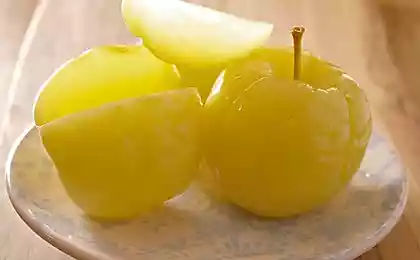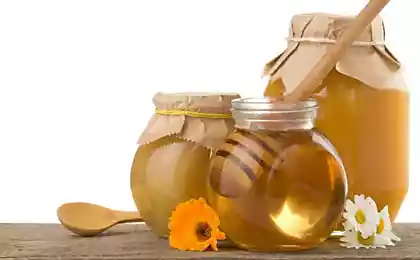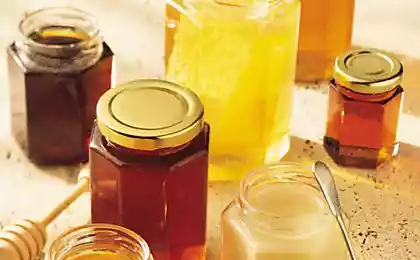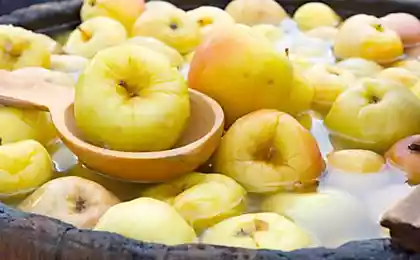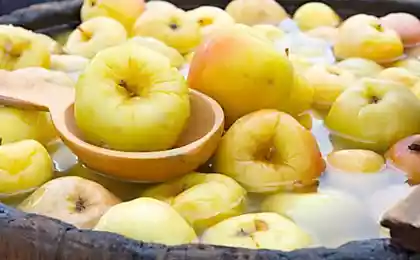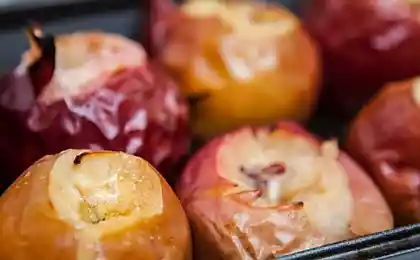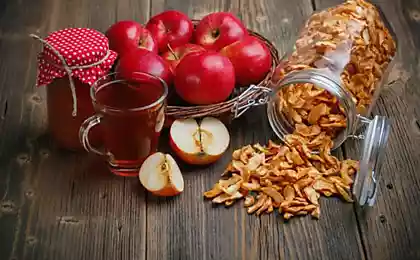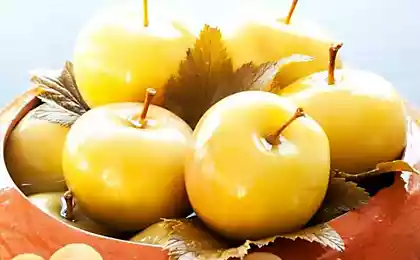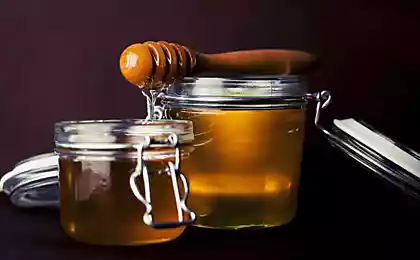652
Traditional Russian recipes pickled apples
There are 2 main ways of cooking pickled apples :
The first way is when the apples are soaked in brine with rye flour (or malted flour);
The second way is when the apples are soaked in honey (sugar or sweet filling).
Variations of pickled apples there are many – for example when both methods are combined ( rye flour + honey (sugar) + salt) or the way when the apples are soaked with berries (cranberries or cranberries..), etc ..
Herbs such as dill, fennel seeds, anise seeds, black pepper, cinnamon, etc.. and the leaves of fruit trees, which shift the layers of apples, can be very different – the leaves of cherries, apples, currants. The only thing you should pay attention to , listing herbs (leaves) and spices is that , if you fill the apples with brine with rye flour (malt) can be added, and spicy leaves (Apple, cherry, and (or) currant), in the case of sweet honey (sugar) pour, dill is better to exclude. In the old pre-revolutionary cookbooks often there are recipes in which the bottom of the tank and between the rows of apples stacked straw (P. Symonenko f "Model kitchen" 1892) .
Apples soaked in rye brine. The apples in honey dressing.
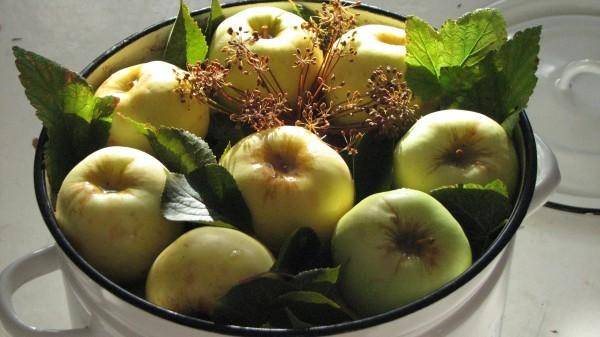
APPLES SOAKED IN RYE BRINE.
Capacity 12 l ( in this case, enameled pan ) requires medium apples (or several large) caliber – 32 – 36 PCs. Apples better to take a variety "Antonovka", but you can use other winter, strong varieties.
Container must be either glass (bottles with wide mouth), either enamel or earthenware (clay covered with glaze, before the industry specially for pickling produced earthenware glazed capacity in the form of barrels of clay circle on which is mounted the yoke). Ideally, as a tank, you need to take small oak barrels)). In any case, the shape of the tank should be close to cylindrical (pot with smooth not "divergent" up the edges. However, a bucket will also work) .
Rye flour – 2-3 cups, dry in the oven ( that she would become the colour of baked milk ). Place the flour in a cast iron skillet ( preferably cast iron because the flour should be left to brew, to warm up, and the cast iron cools long..) and stirring constantly with a whisk, pour in the flour the boiling water – 2-3 liters. Pour boiling water is not very fast but not too slow ( important to stir with a whisk that would, if possible, avoid lumps. If the lumps still formed, rye infusion can be filtered through a sieve..) .
Boil water ( water only, taking into account the one that went to the brewing flour should be 10 liters, i.e., if the brewing flour went 2 years, then boiled water should be 8 l) and add 3 tbsp with "slide" salt (coarse salt not iodized !) .
When the water has cooled, add the rye brewed in the flour and carefully stir the brine. Apples pour the cooled brine.
On the bottom of the tank in which to soak the apples lay herbs ( in this case, the author of the post used the "umbrella" of dill, leaves of cherry and currant), they pack the apples by the stalks up and cover top with herbs. Thus to put all the apples, each time shifting the leaves and herbs. When the capacity is full, the last layer of apples to cover with leaves and herbs placed on top of a wooden circle, covered with gauze in several layers of canvas or better (in order to avoid falling into a container of apples of undesirable objects, dust and so on..), to fix on the container canvas with twine or rubber bands and put oppression.
Stand the apples at room temperature for 3-4 days, then put in the cellar. Care for the pickled apples on the standard scheme – both for pickles. If you soak the apples in the jars, then place in the refrigerator.
40 days ( or after 2 months) the apples are ready to eat.
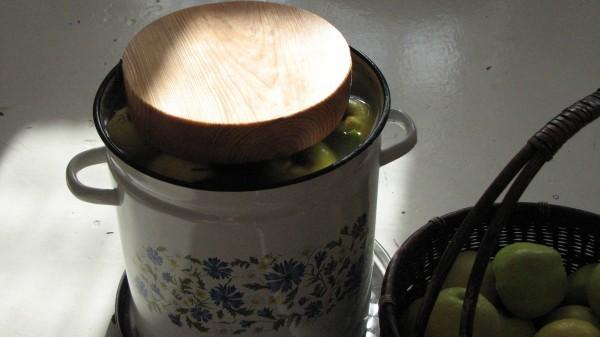
APPLES SOAKED IN HONEY (SWEET) FILLING.
Scheme of laying of apples, number of apples in a 12-liter capacity similar to the previous scheme. The only difference in the fill and in herbs.
Pouring honey :
In 10 liters of water :
honey – 600-800g ( 800 g is for fans of sweet)
salt – 4 tbsp with "slide".
Boil water, add salt, cool it to 40C and (only after the water has cooled to 40C) carefully dilute the honey in there .
Pour prepared apples, to cover the wood around the canvas and set oppression and store - all in the previous recipe .
As herbs use the leaves of the cherry, Apple, currant .
40 days ( or after 2 months) the apples are ready to eat.
IMPORTANT NOTES!
Brine for 12-liter capacity filled with apples is 6-6,5 l. Balance should be maintained (in the fridge), in order to refill once the apples being in the phase of active fermentation, will absorb some of the brine.
In the process of storage ( in the cellar, in the fridge there..) it is necessary to remove the film from the surface of the brine (fill), wash the wooden club, and pour the apples chilled, freshly prepared brine (one word to make sure that the apples are fully submerged in the brine (or fill). published
P. S. And remember, only by changing their consumption — together we change the world! ©
Join us in Facebook , Vkontakte, Odnoklassniki
Source: bufetum.livejournal.com/43828.html
The first way is when the apples are soaked in brine with rye flour (or malted flour);
The second way is when the apples are soaked in honey (sugar or sweet filling).
Variations of pickled apples there are many – for example when both methods are combined ( rye flour + honey (sugar) + salt) or the way when the apples are soaked with berries (cranberries or cranberries..), etc ..
Herbs such as dill, fennel seeds, anise seeds, black pepper, cinnamon, etc.. and the leaves of fruit trees, which shift the layers of apples, can be very different – the leaves of cherries, apples, currants. The only thing you should pay attention to , listing herbs (leaves) and spices is that , if you fill the apples with brine with rye flour (malt) can be added, and spicy leaves (Apple, cherry, and (or) currant), in the case of sweet honey (sugar) pour, dill is better to exclude. In the old pre-revolutionary cookbooks often there are recipes in which the bottom of the tank and between the rows of apples stacked straw (P. Symonenko f "Model kitchen" 1892) .
Apples soaked in rye brine. The apples in honey dressing.

APPLES SOAKED IN RYE BRINE.
Capacity 12 l ( in this case, enameled pan ) requires medium apples (or several large) caliber – 32 – 36 PCs. Apples better to take a variety "Antonovka", but you can use other winter, strong varieties.
Container must be either glass (bottles with wide mouth), either enamel or earthenware (clay covered with glaze, before the industry specially for pickling produced earthenware glazed capacity in the form of barrels of clay circle on which is mounted the yoke). Ideally, as a tank, you need to take small oak barrels)). In any case, the shape of the tank should be close to cylindrical (pot with smooth not "divergent" up the edges. However, a bucket will also work) .
Rye flour – 2-3 cups, dry in the oven ( that she would become the colour of baked milk ). Place the flour in a cast iron skillet ( preferably cast iron because the flour should be left to brew, to warm up, and the cast iron cools long..) and stirring constantly with a whisk, pour in the flour the boiling water – 2-3 liters. Pour boiling water is not very fast but not too slow ( important to stir with a whisk that would, if possible, avoid lumps. If the lumps still formed, rye infusion can be filtered through a sieve..) .
Boil water ( water only, taking into account the one that went to the brewing flour should be 10 liters, i.e., if the brewing flour went 2 years, then boiled water should be 8 l) and add 3 tbsp with "slide" salt (coarse salt not iodized !) .
When the water has cooled, add the rye brewed in the flour and carefully stir the brine. Apples pour the cooled brine.
On the bottom of the tank in which to soak the apples lay herbs ( in this case, the author of the post used the "umbrella" of dill, leaves of cherry and currant), they pack the apples by the stalks up and cover top with herbs. Thus to put all the apples, each time shifting the leaves and herbs. When the capacity is full, the last layer of apples to cover with leaves and herbs placed on top of a wooden circle, covered with gauze in several layers of canvas or better (in order to avoid falling into a container of apples of undesirable objects, dust and so on..), to fix on the container canvas with twine or rubber bands and put oppression.
Stand the apples at room temperature for 3-4 days, then put in the cellar. Care for the pickled apples on the standard scheme – both for pickles. If you soak the apples in the jars, then place in the refrigerator.
40 days ( or after 2 months) the apples are ready to eat.

APPLES SOAKED IN HONEY (SWEET) FILLING.
Scheme of laying of apples, number of apples in a 12-liter capacity similar to the previous scheme. The only difference in the fill and in herbs.
Pouring honey :
In 10 liters of water :
honey – 600-800g ( 800 g is for fans of sweet)
salt – 4 tbsp with "slide".
Boil water, add salt, cool it to 40C and (only after the water has cooled to 40C) carefully dilute the honey in there .
Pour prepared apples, to cover the wood around the canvas and set oppression and store - all in the previous recipe .
As herbs use the leaves of the cherry, Apple, currant .
40 days ( or after 2 months) the apples are ready to eat.
IMPORTANT NOTES!
Brine for 12-liter capacity filled with apples is 6-6,5 l. Balance should be maintained (in the fridge), in order to refill once the apples being in the phase of active fermentation, will absorb some of the brine.
In the process of storage ( in the cellar, in the fridge there..) it is necessary to remove the film from the surface of the brine (fill), wash the wooden club, and pour the apples chilled, freshly prepared brine (one word to make sure that the apples are fully submerged in the brine (or fill). published
P. S. And remember, only by changing their consumption — together we change the world! ©
Join us in Facebook , Vkontakte, Odnoklassniki
Source: bufetum.livejournal.com/43828.html
